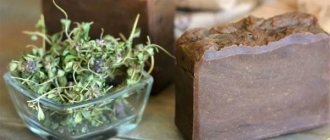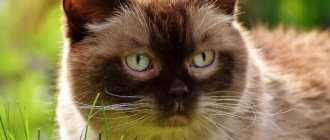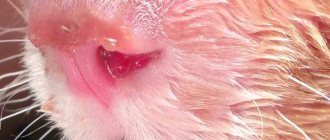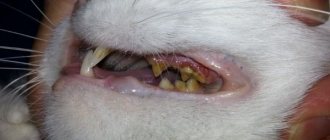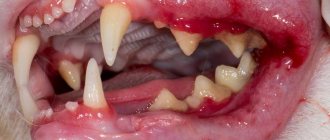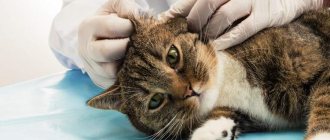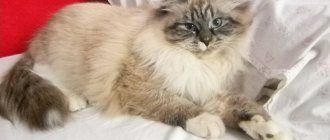Digestive disorder in cats
All cats suffer from digestive problems from time to time, and diarrhea is not uncommon. This condition can cause great harm to kittens whose digestive systems are not yet fully developed.
Digestive disorder in cats leads to weight loss
Mild diarrhea generally lasts 1-2 days and then goes away on its own. When a cat's diarrhea lasts for several days, it becomes dangerous to the pet's health. The cat's body begins to lack fluid and dehydration occurs. The cat loses weight, and its general physical and psycho-emotional condition noticeably worsens.
The veterinarian will conduct a diagnosis, determine the cause of the condition and prescribe a treatment regimen.
If your cat has diarrhea, treatment at home does not bring the desired result, then you need to contact a veterinarian, who will conduct a diagnosis, determine the cause of the condition and prescribe a treatment regimen.
Signs and symptoms of diarrhea in a cat: tips and experience
First of all, the cat owner should distinguish diarrhea from soft feces. Diarrhea in a cat is a symptomatic manifestation characterized by a persistent pathology in which the frequency of bowel movements reaches more than 3 times a day. The animal's stool becomes soft and watery, accompanied by an urgent urge to defecate feces and anal incontinence.
A strong, unpleasant odor from cat feces may indicate a serious illness.
Soft stool is normal and natural and depends on the frequency and type of feeding. Sometimes the appearance and smell of an animal’s feces can make a preliminary diagnosis without the participation of a specialist.
Attention! Cat stool that is mustard yellow in color with watery blisters, blood smears, and a strong foul odor may indicate a serious intestinal infestation.
Bright yellow frequent bowel movements of an animal may indicate a functional disorder of the pancreas. With soft, dark-colored stool with bubbles and a strong fetid odor, there is a possibility of the appearance of obligate anaerobic bacteria that disrupt the microflora of the gastrointestinal tract. If digestive fermentation is disrupted, the smell of a cat's feces becomes sour or pungent, reminiscent of cow dung in smell.
Sources of unpleasant odor from cats and their prevention
If you suspect something is wrong, it is extremely important to quickly identify the sources of the unpleasant odor. Their prevention directly depends on the causes, or more precisely, the processes that are disrupted in the body of pets.
An unpleasant odor can come from the skin, fur, mouth, ears, etc. It is important to understand that it is not the cat itself that smells, but the fluids that are secreted by the body.
Odor from wool and leather
An unpleasant odor from fur and skin most often appears during or immediately after puberty. Owners of young cats often face such problems. Domestic cats live in unnatural conditions, so they do not have the opportunity to mate when they enter the rut. The body experiences a deficiency, so it begins to produce more sex hormones to attract a partner.
Against the backdrop of raging sexual instincts, young cats begin to mark their territory. The cat's fur and skin acquires a pungent, nutmeg odor. Many owners note that the smell lingers throughout the entire home and is impossible to get rid of.
The only method to solve the problem is timely castration of non-breeding animals and the necessary care for cats that are subject to breeding.
It is important to remember that doctors recommend spaying cats before puberty, because if the pet begins to mark, it can become a habit.
Unpleasant odor from the mouth
An unpleasant odor from the mouth can appear when:
- Diseases of the teeth and oral cavity.
- Chronic and acute diseases of the gastrointestinal tract.
- At the stage of eruption of molars.
If an unpleasant odor appears, inspect your pet's mouth. The teeth should be white, the gums should be pink and firm. If you find any inflammation, it is better to consult a veterinarian. If your cat's mouth looks normal, but the breath has an unpleasant odor, the cause may be an incorrect diet or a gastrointestinal disease.
Note! During the eruption of molars, the gums can form hoods under which food becomes trapped. The leftover food begins to rot, resulting in inflammation of the gums and an unpleasant odor from the mouth.
Strong odor of urine
A strong smell of urine may indicate:
- Incorrect diet.
- Chronic or acute disease of the genitourinary system.
- The hormonal system is not functioning properly.
Some foods can affect the acidity of urine. With prolonged improper feeding of a pet, its urine can oxidize or become alkalized, resulting in a strong and very persistent odor .
In most cases, a strong smell of urine indicates stagnation due to urolithiasis or compression of the ureters. The cat cannot empty its bladder in a timely manner, as a result of which the urine becomes dark in color and has a pungent, ammonia-like odor.
Note! During puberty and/or during the rut, a cat's urine begins to smell stronger.
Ear smell
Unpleasant odor from the ears can occur when:
- The presence of prohibited foods in the diet.
- Inflammatory process (otitis).
- Ear mite infestation.
- Food allergies.
A cat's ears are covered with sensitive skin that secretes large amounts of oil and wax to protect it. If the glands do not work properly, the amount of secretions can increase sharply and lead to an unpleasant odor. Food allergies can also cause overactive mucous membranes.
The most common cause of bad ear odor is improper feeding.
Cats have been known to develop smelly ears when fed sweet or starchy foods. Smoked foods, which affect the functioning of the body's mucous membranes, are also strictly prohibited.
Otitis media can occur due to hypothermia, bacterial infection, injury, etc. Inflammation of the ear canals is detected by pain, restlessness of the cat and redness of the skin. To treat otitis, depending on its severity, ear drops or complex therapy are used.
Note! If your cat's ears smell bad or there is a brown coating on the ear flaps, contact your veterinarian immediately. Most likely, you are experiencing symptoms of an ear mite infestation.
The smell from under the tail
An unpleasant odor from under the tail most often occurs due to blockage or inflammation of the anal glands. The root cause of the disease is hereditary factors or improper feeding.
To eliminate the problem, the cat's anal glands are cleaned in a clinic setting. Afterwards, symptomatic therapy, diet and the necessary examination are prescribed. It is important to remember that if the root cause of blocked anal glands is not addressed, this problem will haunt the cat for life.
Smell from the nose
An unpleasant, sweetish or rotten smell from a cat’s nose indicates a fungal infection of the mucous membranes. If you notice whitish or yellow, thick discharge, the odor most likely comes from pus that has accumulated in the sinuses.
No pet is immune from fungal infection. However, infection with fungi occurs only against the background of a decrease in the body's immune defense. Basic nasal discharge most often indicates infection with a viral or bacterial disease that occurs in an acute form.
When should you go to the vet?
Veterinary care for an animal is necessary if, after all available home treatment methods, no improvement in the condition occurs within 2-3 days.
Vomiting in a cat is a sign that the cat is sick
What should be a warning sign for pet owners? Symptoms indicating that your cat is sick:
- the cat’s complete indifference to food;
- vomiting, constant belching;
- bloating and/or flatulence;
Indifference to food is a sign that the cat is sick
- feverish condition of the extremities;
- a sharp deterioration in general physical condition;
- bloody discharge in the stool.
All of these symptomatic signs may indicate more serious illnesses that your pet has.
Tylosin for the treatment of diarrhea in cats
For kittens, severe diarrhea can develop into a critical condition that can be fatal.
Important! When you visit your veterinarian, be sure to bring a fresh sample of your cat's feces that is at least 12 hours old. This is necessary for chemical and biological laboratory testing of animal stool.
A small amount of blood in a cat's stool can be a problem that can easily be corrected with therapeutic treatments. However, if your cat's poop looks black and sticky like tar, it could mean that blood is leaking from the stomach into the colon, which could indicate that your cat is developing a peptic ulcer.
A small amount of blood in a cat's stool can be a problem that can easily be corrected with therapeutic interventions.
After a biochemical laboratory analysis of the blood condition, examination for the presence of intestinal parasites and an ultrasound scan, the veterinarian will recommend the appropriate medication.
Metronidazole for the treatment of diarrhea in cats
In the absence of intestinal infestation, which requires strict veterinary control in a hospital setting, diarrhea or diarrhea in a cat can be stopped by treatment at home using pharmacological drugs such as Prednisolone, Tylosin or Metronidazole.
Why does my cat's feces smell bad?
Dyspepsia
The disease is characterized by a decrease in the production of digestive enzymes. In cats, it most often occurs due to poor nutrition, when the owner spoils his pet with sweets, fatty or smoked meat, and bread. Indigestion in cats can also be caused by a meat diet or consumption of expired foods. With tumors or insufficient secretory function of the pancreas, pancreatic dyspepsia develops. The smell of feces in pathology is pungent, putrid or sour, yellow in color. In a kitten, the disease develops as a result of improper complementary feeding or a rapid transition from one brand of food to another. Symptoms:
- nausea or vomiting after eating;
- bloating;
- reluctance to run or play;
- loss of appetite.
Return to contents
Ulcerative colitis
It is characterized by inflammation of the colon, when the motility of the organ decreases, which impairs the absorption of fluid. The disease develops due to poor nutrition, infection with worms or pathogenic microbes, allergic reactions, accumulation of hair or ingestion of a foreign body, and frequent stress. The poop has a putrid and fetid odor, and the fecal lump is hard. When ulcers form on the walls of the organ, there is an admixture of blood and mucus. Signs:
- pain in the abdomen, the pet does not allow you to touch it;
- vomit;
- false urge to defecate;
- stool instability (constipation alternating with diarrhea);
- weight loss;
- exhaustion.
Return to contents
Steatorrhea
The disease is associated with insufficient digestion, which causes an increase in the content of fatty acids in cat feces. The disease occurs against the background of pathologies of the pancreas, gastritis, dysbacteriosis, liver dysfunction, consumption of fatty foods, deterioration of the absorption process, which is provoked by helminthic infestation, atrophy of intestinal villi, and severe infectious diseases. With steatorrhea, the stool is smelly, has a strong and unpleasant odor. Symptoms differ depending on the underlying disease.
Chronic idiopathic diarrhea
The pathology develops in kittens, but the etiology of the disease has not been identified. The stool is slightly foamy, has a mushy consistency, and smells sour. The disorder lasts until 6 months or one year of age and goes away on its own. The babies still have a good appetite, they are active, curious and gaining weight. If, in addition to these signs, there are no other alarming symptoms, special treatment is not necessary.
Home treatment for diarrhea in cats
After visiting the veterinarian, it is necessary to ensure that all recommendations prescribed by the specialist for diarrhea in a cat are followed.
Treatment at home should begin with the administration of pharmacological drugs. How to properly give your cat the prescribed medicine (instructions):
- Prepare a towel, a syringe with medicine and a syringe with water.
- If a cat has diarrhea, treatment of the disease must be carried out in a small room with the doors closed.
- By wrapping the cat in a towel and holding it firmly in your hand, you can begin the treatment procedure.
- Give the medicine using a syringe or pipette, introducing the drug in small portions into the mouth in a lateral position.
Treatment at home should begin with the administration of pharmacological drugs
- Make sure your cat swallows the medicine.
- The contents of the second syringe are boiled water. It must be given to the cat immediately after administration of the drug - this will help quickly swallow the medicine and remove the unpleasant taste of the drug.
- When following all the veterinarian’s recommendations for treating a cat at home, you must constantly monitor the physical condition of your pet and keep the consulting specialist informed about the developments. If your cat's diarrhea is caused by a chronic intestinal disease, then long-term treatment will most likely be needed. In the absence of clinical pathologies of the gastrointestinal tract, diarrhea that occurs in a cat can be quickly eliminated by treatment at home and normal gastrointestinal functions can be restored. The animal will gain weight, the general physical condition of the pet will improve, and the cat’s health will not worry the owner.
Cat nutrition is the cause of pathology
Diarrhea in a pet can be caused by a change in diet. If diarrhea occurs within 1-2 days after changing cat food, then it is likely that this is the body’s reaction to a new type of food. It is recommended to return to proven food, and introduce a new type of food gradually.
Diarrhea in a pet may be caused by a new type of food
We should not forget about monitoring the animal's feces. In addition, a new type of cat food can cause food allergies, which will cause diarrhea in the cat. Your veterinarian may recommend switching to a high-fiber diet.
New food may cause stomach upset in cats
It is necessary to gradually add new food to your pet's diet. The correct proportional ratio of products is 9:1, that is, 90% old food and 10% new. Gradually, the cat gets used to the new food, and problems with digestive disorders will disappear.
Add fiber-rich foods
Vanya cat.
There are no unimportant diseases.
There is a widely held opinion that if a cat “rides” on its butt, then it is probably tormented by worms. True, this isn’t about your beloved and beloved pet, is it? You do not forget about regular anthelmintic measures (tablets, sweet suspensions or drops on the withers), as well as vaccinations against infections and treatment for fleas and other “bloodsuckers”. Then what is the reason? And the reason for such unusual and even unworthy behavior of your noble/high-ranking pet is that his anal glands (sinuses) are probably inflamed.
Having learned about this diagnosis (or rather diagnoses: paraproctitis, paraanal sinusitis), most visitors to veterinary clinics exclaim: what kind of misfortune is this? Well, first of all, the problem is not in the mouth, but precisely on the opposite part of the digestive tract.
The fact is that in the immediate vicinity of the anus (anus) in most mammals, the ducts of the paraanal glands open (para - from the Latin about, and anal - anal). These are small holes (as if pierced with a needle) located on the sides of the anus (they can be seen if you slightly open the anus). Normally, the secretion of these glands is constantly released during the act of defecation. However, in the case:
non-compliance with basic hygiene rules (accumulation of feces under the tail),
physical inactivity (coupled with obesity) and/or
unbalanced nutrition, leading to too soft or even loose stools,
these glands become inflamed, the secretion begins to accumulate in the capsule (cavity) of the gland and causes unpleasant pain in the animal. It is the release of a large amount of disgusting mass, both in appearance and smell, when pressing under the cat’s tail that is the main diagnostic sign of this disease.
In addition, inflammation very quickly spreads to the tissue surrounding the anus (even blood poisoning may eventually develop). Cats begin to intensively lick under their tails, ride on their butts, become restless or even aggressive.
If adequate measures are not taken in time and the ducts and capsule of the gland are not cleaned or washed, intense bacterial inflammation occurs and pus breaks out in the perineal area. It looks like a terrible ulcer (the skin in this area is thin and breaks easily) and, of course, requires immediate surgical intervention (and a decent amount of money, of course). Sometimes the matter can even result in partial loss of innervation of the hind limbs (paraparesis) and/or release of purulent contents into the abdominal cavity. Therefore, put your hands on your feet, put the cat in the carrier and run to the doctor.
Treatment or one in the field is not a warrior!
Treatment of paraanal problems is possible only in a veterinary clinic. If the disease is very advanced, then general anesthesia may even be required. In any case, no cat with a sound mind and strong memory will allow all the necessary procedures to be carried out on her without a fight. And in order to carry out complex treatment (especially during the initial treatment), it is necessary:
-correctly, firmly, securely fix the animal on the table (to avoid bloodshed, and in general for the possibility of treatment) and move the tail back as much as possible (one cat requires at least two people with secondary or higher veterinary education);
-squeeze out the purulent contents of the glands and rinse them through the catheter with an antiseptic solution (this is practically a jeweler’s work, since the cat is a small animal, and even an experienced doctor may not find the ducts of the required glands right away, and this... plus one more person for the same cat);
-and finally, inject the affected area with antibiotics and insert an anti-inflammatory suppository (or an ointment similar in effect) into the anus;
All this time, most of the cats scream heart-rendingly at the top of their lungs (and sometimes completely incommensurate with the pain they experience), and try to escape from the hands of the “torturers.” The spectacle, frankly speaking, is not for the faint of heart.
Prevention is the key to success
The area around the tail requires the same constant care as the eyes and ears (hygiene is the key to health, equally for all parts of the body). Moreover, there is nothing complicated in the specific prevention of paraproctitis. Regular (once a week, for example) squeezing the sinuses will almost certainly save your patient (and you, of course) from a lot of trouble. It is best to ask your doctor about how you can do this yourself (in technical and practical terms). One or two practical lessons and paraproctitis will forever forget the way to your home.
What are they needed for
Anal (paraanal) glands are special derivatives of sweat and sebaceous glands, the odorous, fetid (to the human nose, of course) secretion serves for communicative functions (marking territory or attracting individuals of the opposite sex, for example). The secretion of these glands also serves to scare away enemies (skunks are world famous thanks to these glands). The secretion of the paraanal sinuses not only has a completely unique smell, but is also much more durable than the most expensive perfume delights. Therefore, getting this natural “flavor” on clothes or furniture is extremely undesirable.
Roman Leonard, chief physician of the clinic.
Author: Site Administrator | 03/14/2016
Maria Osipovna is ready to strangle her own unwashed cat. He stinks so much of urine that it stops him from breathing. What should an old lady do? Put the poor guy to sleep or grow wiser?
For God's sake, forgive me, dear readers.
What should you consider when feeding your pet?
In order for your pet to feel comfortable and recover quickly, it is necessary to provide him with proper nutrition and comply with all sanitary and hygienic standards for keeping a pet:
- Cooked products should not contain any types of spices, including salt.
- Use only fresh food and proven feed from certified manufacturers.
It is not recommended to use spices when feeding your pet.
- You should pay attention to the temperature. Cat food should not be too hot or cold. The best option is room temperature or slightly warm food.
- During home treatment of diarrhea in a cat, it is necessary to give food in small portions 5-6 times a day.
- To protect the cat's digestive system from helminthiasis, all food products made from meat and fish must undergo heat treatment.
- While treating a cat for diarrhea, you should not give it dairy products.
Important! When treating diarrhea in a cat at home, constant consultation with a specialist is necessary who will help adjust the living conditions of the pet and its diet.
When it tastes like porridge
Things are more complicated if the dog or cat's stool has a consistency similar to porridge: the feces do not have a clear shape, but they also do not look like water. They lie in a heap and are difficult to remove from the ground or tray.
We recommend reading: How long does a dog go into heat?
One of the possible causes of digestive upset is malnutrition. For example, an incorrectly selected diet, spoiled foods, treats that are not intended for animals, or a sudden change in types of food (switching from porridge to another food or vice versa). If it's really just a matter of feeding, then it's easy to fix.
But diet is not the only cause of mushy stool. It may also be due to infection, neoplasm, or inflammatory bowel disease. In any case, you cannot do without consulting a specialist.
Preventing diarrhea in cats
The well-being of the cat in 99% of cases depends on the pet owner.
Certified cat food
The breeder should know the following about the health status of his pet:
- stomach sensitivity;
- intolerance to feed;
- reaction to allergens;
- functional state of the digestive organs and the entire gastrointestinal tract.
Pet food should always be fresh; stale food from yesterday is not allowed; this is especially important in the summer. Certified cat food must contain a high percentage of meat. Make sure your cat's digestion is normal. The physical activity of the animal is of no small preventive importance.
Make sure your cat's digestion is normal
The animal's bedding or mat should always be kept clean, as should the litter tray. Regular visits to the veterinarian to deworm the animal is another preventive measure against intestinal inflammation and other pathological conditions of the digestive system.




